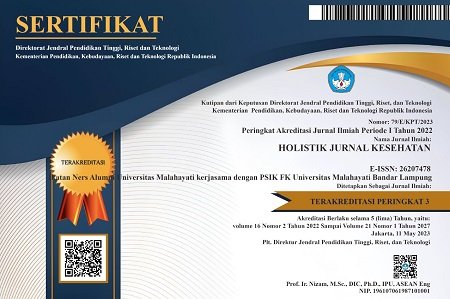Intervensi pencegahan kekerasan seksual pada remaja: Literature review
Abstract
Background: Sexual abuse in adolescents is a worrying problem, and has a serious physical, mental, and psychological impact on the victims.
Purpose: To analyze effective interventions in preventing sexual violence in adolescents.
Method: This literature review used the Preferred Reporting Items for Systematic Reviews (PRISMA) guide with the keywords “Intervention” AND “sexual violence” AND “prevention” AND “youth” using the Science Direct, PubMed, Medline, ProQuest, and Sage Journal databases. The inclusion criteria included full text, in English, and the year of publication ranged from 2010 to 2020. 23,517 articles were collected according to keywords and 9 articles were selected that met the quality requirements.
Results: Based on the literature review, there were 5 intervention groups including interventions using school-based sexual education curricula, media games and educational games, mixed interventions, support groups, and workshops which proved effective in preventing sexual violence in adolescents.
Conclusion: Various interventions have been found to be effective so that they can be used as a youth sexual violence prevention program. In research, it is rare to find the involvement of nurses and families in carrying out interventions.
Suggestion: The findings of this study can be input for further research related to the prevention of sexual violence in adolescents by involving the role of the family and the role of nurses. This study can be a reference for policymakers in determining preventive actions that can be taken to reduce sexual violence in adolescents.
Keywords: Adolescents; Intervention; Literature Review; Prevention; Sexual Abuse
Pendahuluan: Kekerasan seksual pada remaja menjadi permasalahan yang mengkhawatirkan, berdampak serius pada fisik, mental dan psikologis pada korbannya.
Tujuan: Untuk menganalisa intervensi yang efektif dalam pencegahan kekerasan seksual pada remaja.
Metode: Literature review ini menggunakan panduaan Preferred Reporting Items for Systematic Reviews (PRISMA) dengan kata kunci “Intervensi” AND “kekerasan seksual” AND “pencegahan” AND “remaja” dengan menggunakan database Science Direct, PubMed, Medline, ProQuest, dan Sage Journal. Kriteria inkluasi meliputi fulltext, berbahasa inggris, dan rentang tahun publikasi antara 2010 sampai 2020. Terkumpul 23.517 artikel sesuai dengan kata kunci dan terpilih 9 artikel yang memenuhi syarat kualitas.
Hasil: Berdasarkan literature review terdapat 5 kelompok intervensi diantaranya, intervensi menggunakan kurikulum pendidikan seksual berbasis sekolah, pemanfaatan media permainan dan game edukasi, intervensi campuran, support group, dan lokakarya yang terbukti efektif dalam mencegah kekerasan seksual pada remaja.
Simpulan: Berbagai intervensi yang ditemukan efektif sehingga dapat digunakan menjadi program pencegahan kekerasan seksual remaja. Pada penelitian jarang ditemukan keterlibatan perawat dan keluarga dalam melakukan intervensi.
Saran: Temuan studi ini dapat menjadi masukan untuk penelitian selanjutnya terkait pencegahan kekerasa seksual pada remaja dengan melibatkan peran keluarga dan peran perawat. Studi ini dapat menjadi rujukan bagi pemegang kebijakan dalam menentukan tindakan pencegahan yang dapat dilakukan untuk menurunkan kekrasan seksual pada remaja.
Keywords
References
American Psychological Association. (2003). A Reference fro Professionals Developing Adolescents. Choice Reviews Online, 40(12), 40Sup-0578-40Sup – 0578. https://doi.org/10.5860/choice.40sup-0578
Anggreni, D., & Notobroto, B. (2017). Hubungan Pola Pengasuhan Orang Tua Dengan Tindakan Pencegahan Kekerasan Seksual Pada Anak (Studi Kasus Dalam Rangka Pencegahan Kekerasan Seksual Pada Anak di Kota Mojokerto) Dhonna, 9(1), 9–17.
Baker, C. K., Naai, R., Mitchell, J., & Trecker, C. (2014). Utilizing a train-the-trainer model for sexual violence prevention: Findings from a pilot study with high school students of Asian and Pacific Islander descent in Hawaia’i. Asian American Journal of Psychology, 5(2), 106–115. https://doi.org/10.1037/a0034670
Basile, K., DeGue, S., Jones, K., Freire, K., Dills, J., Smith, S. G., & Raiford, J. L. (2016). STOP SV: A Technical Package to Prevent Sexual Violence. CDC - Division of Violence Prevention, 1–48. https://doi.org/10.1016/j.arbr.2013.11.006
Batubara, J. R. (2016). Adolescent Development (Perkembangan Remaja). Sari Pediatri, 12(1), 21. https://doi.org/10.14238/sp12.1.2010.21-9
Boduszek, D., Debowska, A., Jones, A. D., Ma, M., Smith, D., Willmott, D., Jemmott, E. T., Da Breo, H. & Kirkman, G. (2019). Prosocial video game as an intimate partner violence prevention tool among youth: A randomised controlled trial. Computers in Human Behavior, 93(December 2018), 260–266. https://doi.org/10.1016/j.chb.2018.12.028
Cohen, J. R., Shorey, R. C., Menon, S. V., & Temple, J. R. (2018). Predicting teen dating violence perpetration. Pediatrics, 141(4). https://doi.org/10.1542/peds.2017-2790
Coker; A. L., Bush, H. M., Fisher, B. S., Swan, S. C., Williams, C. M., Clear, E. R., & DeGue, S. (2016). Multi–College Bystander Intervention Evaluationon for Violence Prevention. Physiology & Behavior, 176(1), 139–148. https://doi.org/10.1016/j.physbeh.2017.03.040
Coker, A. L., Fisher, B. S., Bush, H. M., Swan, S. C., Williams, C. M., Clear, E. R., & DeGue, S. (2015). Evaluation of the Green Dot Bystander Intervention to Reduce Interpersonal Violence Among College Students Across Three Campuses. Violence against Women, 21(12), 1507–1527. https://doi.org/10.1177/1077801214545284
DeGue, S., Valle, L. A., Holt, M. K., Massetti, G. M., Matjasko, J. L., & Tharp, A. T. (2014). A systematic review of primary prevention strategies for sexual violence perpetration. Aggression and Violent Behavior, 19(4), 346–362. https://doi.org/10.1016/j.avb.2014.05.004
Dewi, R. L., Rahman, I. K., & Supraha, W. (2018). 25 Psikoedukasi Islami Pendidikan Seks Sebagai Medium Alternatif Pencegahan Kekerasan Seks Pada Anak. Prosiding Bimbingan Konseling, 220–231. Retrieved from http://pkm.uika-bogor.ac.id/index.php/PSBKI/article/view/146
Feng, D., Kim, J., Khadra, M., Hudson, D. L., & Roux, C. (2015, January). Guest-editorial: Telehealth systems and applications. IEEE Journal of Biomedical and Health Informatics. United States. https://doi.org/10.1109/JBHI.2014.2380132
Foshee, V. A., Benefield, T., Dixon, K. S., Chang, L.-Y., Senkomago, V., Ennett, S. T., Moracco, K. E., & Bowling, J. M. (2015). The effects of moms and teens for safe dates: a dating abuse prevention program for adolescents exposed to domestic violence. Journal of Youth and Adolescence, 44(5), 995–1010. https://doi.org/10.1007/s10964-015-0272-6
Fuadi, M. A. (2012). Dinamika Psikologis Kekerasan Seksual: Sebuah Studi Fenomenologi. PSIKOISLAMIKA: Jurnal Psikologi Dan Psikologi Islam, 0(0), 191–208. Retrieved from http://ejournal.uin-malang.ac.id/index.php/psiko/article/view/1553
Halpern, C. T., Spriggs, A. L., Martin, S. L., & Kupper, L. L. (2009). Patterns of intimate partner violence victimization from adolescence to young adulthood in a nationally representative sample. The Journal of Adolescent Health : Official Publication of the Society for Adolescent Medicine, 45(5), 508–516. https://doi.org/10.1016/j.jadohealth.2009.03.011
Hébert, M., Lavoie, F., & Blais, M. (2014). Post Traumatic Stress Disorder/PTSD in adolescent victims of sexual abuse: resilience and social support as protection factors. Ciencia & Saude Coletiva, 19(3), 685–694. https://doi.org/10.1590/1413-81232014193.15972013
Izaguirre, A., & Calvete, E. (2017). Exposure to Family Violence as a Predictor of Dating Violence and Child-to-Parent Aggression in Spanish Adolescents. Youth and Society, 49(3), 393–412. https://doi.org/10.1177/0044118X16632138
Joanna Briggs Institute. (2017). Checklist for Randomized Controlled Trials. Joanna Briggs Institute, 1–9. https://doi.org/10.1371/journal.pgen.1000960
Kann, L., Kinchen, S., Shanklin, S. L., Flint, K. H., Hawkins, J., Harris, W. A., Lowry, R., Olsen, E.O.M., McManus, T., Chyen, D. & Whittle, L. (2014). Youth risk behavior surveillance--United States, 2013. MMWR Supplements, 63(4), 1–168.
Komisi Nasional Anti Kekerasan terhadap Perempuan. (2020). Kekerasan Meningkat: Kebijakan Penghapusan Kekerasan Seksual untuk Membangun Ruang Aman bagi Perempuan dan Anak Perempuan. Komnas Perempuan. Retrieved from https://www.komnasperempuan.go.id/file/pdf_file/2020/Catatan Tahunan Kekerasan Terhadap Perempuan 2020.pdf
Komisi Perlindungan Anak Indonesia. (2017). 71Ad6-Buku-Ktpa-Meneg-Pp-2017.
Levy, S. R., Perhats, C., Weeks, K., Handler, A. S., Zhu, C., & Flay, B. R. (1995). Impact of a school-based AIDS prevention program on risk and protective behavior for newly sexually active students. The Journal of School Health, 65(4), 145–151. https://doi.org/10.1111/j.1746-1561.1995.tb06218.x
López, S., Faro, C., Lopetegui, L., Pujol-Ribera, E., Monteagudo, M., Avecilla-Palau, À., Martínez, C., Cobo, J. & Fernández, M.-I. (2017). Child and Adolescent Sexual Abuse in Women Seeking Help for Sexual and Reproductive Mental Health Problems: Prevalence, Characteristics, and Disclosure. Journal of Child Sexual Abuse, 26(3), 246–269. https://doi.org/10.1080/10538712.2017.1288186
Mohammed, G. F., & Hashish, R. K. H. (2015). Sexual violence against females and its impact on their sexual function. Egyptian Journal of Forensic Sciences, 5(3), 96–102. https://doi.org/https://doi.org/10.1016/j.ejfs.2014.08.004
Moor, A. (2011). The Efficacy of a High School Rape Prevention Program in Israel, 26(3), 283–296. https://doi.org/10.1891/0886-6708.26.3.283
Munasti, U. W. (2019). Jurnal Ilmiah Mahasiswa Bimbingan dan Konseling Volume 4 Nomor 4 tahun 2019 Desember 2019, 4, 74–80.
Muñoz-Fernández, N., Ortega-Rivera, J., Nocentini, A., Menesini, E., & Sánchez-Jiménez, V. (2019). The efficacy of the “Dat-e Adolescence” prevention program in the reduction of dating violence and bullying. International Journal of Environmental Research and Public Health, 16(3). https://doi.org/10.3390/ijerph16030408
Niolon, P. H., Vivolo-Kantor, A. M., Tracy, A. J., Latzman, N. E., Little, T. D., DeGue, S., Lang, K.M., Estefan, L.F., Ghazarian, S.R., McIntosh, W.L.K. & Taylor, B. (2019). An RCT of Dating Matters: Effects on Teen Dating Violence and Relationship Behaviors. American Journal of Preventive Medicine, 57(1), 13–23. https:// doi.org /https:// doi.org/10.1016 /j.amepre.2019.02.022
Nurbaya, N. (2019). Prosiding Seminar Nasional 2019 Seksual Pada Anak Remaja Awal di SD Islam Terpadu Nurul Fikri Makassar Prosiding Seminar Nasional 2019, 2, 26–27.
Reidy, D. E., Holland, K. M., Cortina, K., Ball, B., & Rosenbluth, B. (2017). Evaluation of the expect respect support group program: A violence prevention strategy for youth exposed to violence. Preventive Medicine, 100, 235–242. https://doi.org/10.1016/j.ypmed.2017.05.003
Rizzo, C. J., Joppa, M., Barker, D., Collibee, C., Zlotnick, C., & Brown, L. K. (2018). Project Date SMART : a Dating Violence ( DV ) and Sexual Risk Prevention Program for Adolescent Girls with Prior DV Exposure, 416–426.
Shekar, A., Gross, A., Luebbers, E., & Honsky, J. (2020). Effects of an Interprofessional Student-Led Sexual Education Program on Self-Efficacy and Attitudes About Sexual Violence in Youths in Juvenile Detention. Journal of Pediatric and Adolescent Gynecology. https://doi.org/10.1016/j.jpag.2019.12.005
Shuaib, F. M. B., Ehiri, J. E., Jolly, P., Zhang, Q., Emusu, D., Ngu, J., Foushee, H., Katongole, D., Kirby, R. & Wabwire-Mangen, F. (2012). Sexual violence and associated factors among women in HIV discordant and concordant relationships in Uganda. International Journal of Adolescent Medicine and Health, 24(2), 125–133. https://doi.org/10.1515/ijamh.2012.019
Silverman, J. G., Servin, A., Goldenberg, S. M., Magis-Rodriguez, C., Ritter, J., Raj, A., & Brouwer, K. C. (2015). Sexual Violence and HIV Infection Associated With Adolescent vs Adult Entry Into the Sex Trade in Mexico. JAMA, 314(5), 516–518. https://doi.org/10.1001/jama.2015.7376
Taylor, B. G., Mumford, E. A., Liu, W., & Stein, N. D. (2017). The effects of different saturation levels of the Shifting Boundaries intervention on preventing adolescent relationship abuse and sexual harassment. Journal of Experimental Criminology, 13(1), 79–100. https://doi.org/10.1007/s11292-016-9277-8
Tharp, A. T., DeGue, S., Valle, L. A., Brookmeyer, K. A., Massetti, G. M., & Matjasko, J. L. (2013). A systematic qualitative review of risk and protective factors for sexual violence perpetration. Trauma, Violence & Abuse, 14(2), 133–167. https://doi.org/10.1177/1524838012470031
United Nations Children’s Fund (UNICEF). (2014). A Statistical Snapshot of Violence Against Adolescent Girls, 1–25.
World Health Organization. (2018). Responding to children and adolescents who have been sexually abused: WHO recommendations. Paediatrics and International Child Health (Vol. 38). https://doi.org/10.1080/20469047.2018.1427179
Yom, Y.-H., & Eun, L. K. (2005). Effects of a CD-ROM educational program on sexual knowledge and attitude. Computers, Informatics, Nursing : CIN, 23(4), 214–219. https://doi.org/10.1097/00024665-200507000-00009
DOI: https://doi.org/10.33024/hjk.v17i6.12630
Refbacks
- There are currently no refbacks.
Copyright (c) 2023 Holistik Jurnal Kesehatan

This work is licensed under a Creative Commons Attribution-NonCommercial 4.0 International License.














